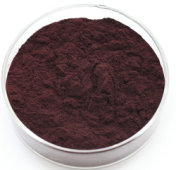OEM/ODM China Bilberry extract Factory for Bahrain
OEM/ODM China Bilberry extract Factory for Bahrain Detail:
[Latin Name] Vaccinium myrtillus l.
[Plant Source] Wild bilberry fruit cultivated from Sweden & Finland
[Specifications]
1) Anthocyanidins 25% UV (Glycosyl removed)
2) Anthocyanins 25% HPLC
3) Anthocyanins 36% HPLC
[Particle size] 80 Mesh
[Loss on drying] ≤5.0%
[Heavy Metal] ≤10PPM
[Pesticide residue] EC396-2005, USP 34, EP 8.0, FDA
[Storage] Store in cool & dry area, keep away from the direct light and heat.
[Package] Packed in paper-drums and two plastic-bags inside.
[General feature]
1. 100% extracted from European bilberry fruit, approved ID test from ChromaDex andAlkemist Lab;
2.Without any adultery of other relative species of Berries,such as Blueberry, Mulberry,Cranberry,etc;
3. Pesticide residue: EC396-2005, USP 34, EP 8.0, FDA
4. Directly import the frozen fruit from North Europe;
5. Perfect water solubility,water insolubles<1.0%
6. Chromatographic fingerprint match EP6 requirement
[What is bilberry fruit]
Bilberry (Vaccinium Myrtillus L.) is a kind of perennial deciduous or evergreen fruit shrubs, mainly found in subarctic regions of the world as in Sweden, Finland and Ukraine, etc. Bilberries contain dense levels of anthocyanin pigments, which was said popularly to have been used by World War II RAF pilots to sharpen night vision. In fork medicine, Europeans have been taking bilberry for a hundred years. Bilberry extracts entered the healthcare market as a kind of dietary supplement for effects on vision enhancement and visual fatigue relief.
[Function]
Protect and regenerate rhodopsin and cure the eye diseases;
Prevent the cardiovascular diseases
Antioxidant and anti-aging
Softening blood capillary, enhancing the heart function and resisting cancer
Product detail pictures:

Related Product Guide:
The company upholds the philosophy of "Be No.1 in quality, be rooted on credit and trustworthiness for growth", will continue to serve old and new customers from home and overseas whole-heatedly for OEM/ODM China Bilberry extract Factory for Bahrain , The product will supply to all over the world, such as: Puerto Rico, Malta, Barbados, Our company offers the full range from pre-sales to after-sales service, from product development to audit the use of maintenance, based on strong technical strength, superior product performance, reasonable prices and perfect service, we'll continue to develop, to supply the high-quality goods and services, and promote lasting cooperation with our customers, common development and create a better future.
Maitake is an edible mushroom species often referred to as “hen of the woods.” Containing specific beta-glucan polysaccharides, known as grifolan and D-fraction, it is especially helpful for stimulating immune functions with many studies on its beneficial antitumor effects. Learn about our top recommended extract choices for nutritional supplementation as well as harvesting or cultivating your own maitake and how to use and prepare it.
Fungi Perfecti Host Defense, Maitake, 120caps – https://amzn.to/2ftJ0hz
Mushroom Wisdom Maitake D-Fraction Pro 4X Liquid, 1oz – https://amzn.to/1yfLu63
Mushroom Wisdom Maitake D-Fraction, 120caps – https://amzn.to/1M7HMau
Mushroom Science Maitake Full Spectrum Extract, 90 caps – https://bit.ly/1By7HQn
Mushroom Wisdom Maitake D-Fraction Immune System Support, 2oz – https://amzn.to/2gr3Hgb
Organic Maitake Mushroom Growing Kit – https://amzn.to/2fWTt8S
Maitake Mushroom Pieces, Mountain Rose Herbs, Organic, 1oz-1lb – https://bit.ly/2fKARpS
Maitake Extract, Mountain Rose Herbs, 1-4oz – https://bit.ly/2grahmE
Planetary Formulas Full Spectrum Maitake Mushroom, 60tabs – https://amzn.to/2g9HxOT
Super Mushrooms Store: https://bit.ly/1GGruBG
Maitake Page: https://bit.ly/1Gtn8KE
Additional Sourced Info:
Effect of Maitake (Grifola frondosa) D-Fraction on the activation of NK cells in cancer patients: https://1.usa.gov/1C8rl97
Administration of a polysaccharide from Grifola frondosa stimulates immune function: https://1.usa.gov/1GtmuNl
Maitake: The Magnificent ‘Dancing’ Mushroom: https://huff.to/1wfz3qH
Antitumor effect of polysaccharide grifolan NMF-5N on syngeneic tumor: https://1.usa.gov/1wvRVGM
Relationship between solubility of grifolan, a fungal 1,3-beta-D-glucan, and production of tumor necrosis factor by macrophages: https://1.usa.gov/19cW4VL
Immune-enhancing effects of Maitake (Grifola frondosa) and Shiitake (Lentinula edodes) extracts: https://1.usa.gov/18BCqBC
Synergistic potentiation of D-fraction with vitamin C as possible alternative approach for cancer therapy: https://1.usa.gov/1Bsv1QG
Can maitake MD-fraction aid cancer patients?: https://1.usa.gov/1Bsvgvj
Genes Related to Suppression of Malignant Phenotype Induced by Maitake D-Fraction in Breast Cancer Cells: https://1.usa.gov/1xeaU3E
Enhancement of cytotoxicity of NK cells by D-Fraction, a polysaccharide from Grifola frondosa: https://bit.ly/1E6WCEt
The Pharmacological Potential of Mushrooms: https://1.usa.gov/1GGr6TE
Maitake (Grifola frondosa) improve glucose tolerance of experimental diabetic rats: https://1.usa.gov/1MuuBNj
Anti-diabetic activity present in the fruit body of Grifola frondosa (Maitake): https://1.usa.gov/1C8rZTY
Maitake Mushroom Extracts Ameliorate Progressive Hypertension: https://1.usa.gov/18BCIZn
The effect of maitake mushrooms on liver and serum lipids: https://1.usa.gov/1NM2HxV
All information is for educational purposes only and is the personal view of the author; not intended as medical advice,
diagnosis or prescription. This information has not been evaluated by the FDA and is not intended to cure or prevent any disease.
复合多糖,被誉为“第三个世界药物革命”,是当今世界上优质且无任何毒副作用的最佳免疫调节剂,享誉全球。
你想了解它的威力吗?
听听冯秉武教授的分享。
冯秉武教授简介:
- 参与无限极增健口服液(养固健)的研发过程
- 南方医科大学(原第一军医大学)教授,大校军衔
- 早年临床工作十七年,曾任主治军医及所长
- 论文及成果曾数次获得军队科技进步奖,并参与“军事医学百科全书”等专著的编写
- 中华中医药学会会员
- 中华中医药学会养生文化推广专家指导委员会成员
High Quality, High Efficiency, Creative and Integrity, worth having long-term cooperation! Looking forward to the future cooperation!









